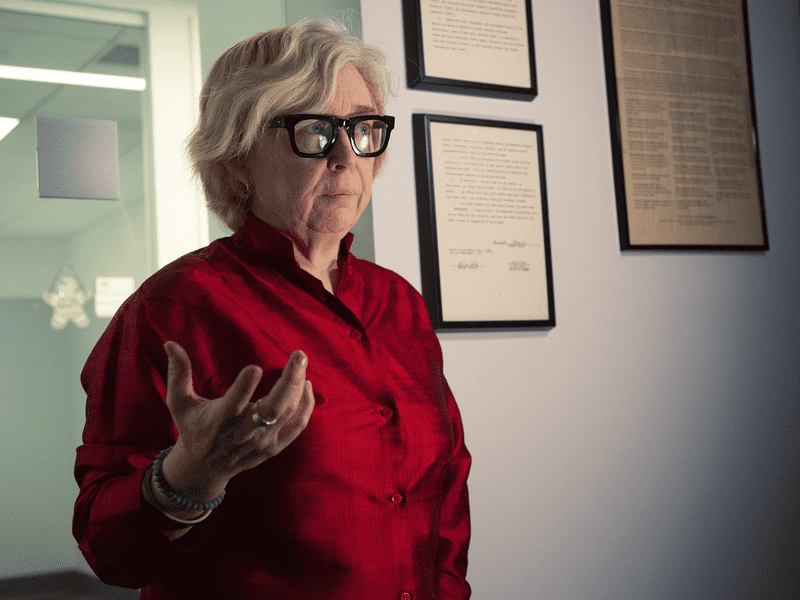Kai Wright Presents Blindspot Episode 3: ‘Women Don’t Get AIDS, They Just Die From It’

( Kia LaBeija )
[music]
Kai Wright: Hey, it's Kai, back with another bonus episode for you. This is the third installment of Blindspot: The Plague in the Shadows, which I co-reported with my colleague Lizzy Ratner. It's a history of the early days of the AIDS epidemic told from the perspective of communities that have too often been overlooked in that history. So much about the epidemic was misunderstood in the '80s and even into the '90s.
Today's episode is about a group of women who organized to change the very definition of AIDS and did it in part from prison. If you haven't heard the first two episodes of Blindspot, they're waiting for you right here in this podcast feed. You can find more information about this series in our show notes. Also, right after this episode, I have a special announcement about Notes from America. Stick around and I'll tell you more about it after we hear the stories of some fearless women who made a difference.
Maxine Wolfe: One, two, three, four. Testing, one, two, three, four. This is the CDC in Atlanta on November 19th, 1990.
Lizzy Ratner: That's Maxine Wolfe. She's 49 years old and she is fierce. She's just flown down to Atlanta from New York City to meet with experts from the Centers for Disease Control. Now, Maxine, she is not a doctor and she's not a health professional. She is an activist, and she's come with a tape recorder.
Maxine Wolfe: Make you a copy that you can have. It's just that it's easy.
Lizzy Ratner: I'm Lizzy Ratner. It's now 1990, and we are nine years into the epidemic. More than 100,000 people have died, gay men are getting sick in mind-boggling numbers, but they are also fighting back. Women, the world is just pretty much-ignoring women with HIV. Maxine, she's been going to a lot of these kinds of meetings.
Maxine Wolfe: What you may not know is that we are women who have been focusing on the issue of women and AIDS for years, years. We are activists. No offense, but we are not impressed by doctors, nor are we impressed by medicine in general because we know that those two groups have never cared about women. We literally had to convince the federal government that there were women getting HIV. We actually had to develop treatment and research agendas that were about women.
Kai Wright: To be clear, women could and did test positive for HIV, and technically, the government knew this. The problem was, it wasn't doing much about it. Maxine, she and a bunch of other activists were trying to change this.
Lizzy Ratner: Maxine was part of the women's committee of ACT UP, and they had been pushing for a meeting with the CDC for months. Now, finally, they found themselves in a conference room in Atlanta, giving a presentation to some of the foremost experts on HIV and AIDS.
Maxine Wolfe: The way we'd like to do it is that Katrina is going to talk first about some of the issues that she has seen.
Katrina Haslip: Women die six times faster than men with HIV or AIDS.
Lizzy Ratner: Katrina Haslip, she's only 31, but she is already a veteran activist for women with HIV and AIDS. She's the only Black woman in the room. She is small in stature, but she commands attention.
Katrina Haslip: I don't trust the CDC or its definition because it appears that from a distance people are watching as we progress on. Knowing that these series of symptoms are in fact progression to full-blown AIDS and they're not responding.
Lizzy Ratner: To give you some context as to why Maxine and Katrina had to work so hard to get those people in that Atlanta conference room to see women with HIV. AIDS had been framed as a man's disease, a gay man's disease. Lots of people from your average member of the public to high-ups in the medical establishment, they just weren't thinking about women. A lot of them didn't even know that women could get HIV.
Kai Wright: The problem went deeper than that. Medicine was a male profession, had been for as long as anyone could remember. Sexism came with those white coats, or most white coats anyway.
Howard Minkoff: I'm the emeritus chair of two hospitals in Brooklyn, Downstate Medical--
Kai Wright: Howard Minkoff was an OBGYN in Brooklyn.
Howard Minkoff: In the '80s, women were disposable. In those days, most of the women weren't cared about at all compared to the frail, pale, male as the old white guys are called these days. There is a difference in the way society weighs their rights and their values. It just became more apparent during the AIDS epidemic.
Dr. Kathy Anastos: I saw myself as an inside-the-system activist.
Lizzy Ratner: Dr. Kathy Anastos, she became an AIDS expert through her work at Montefiore Medical Center in the Bronx.
Dr. Kathy Anastos: Because I was one of the first doctors to speak up about HIV in women, and that we needed to know more.
Lizzy Ratner: That lack of knowledge about women and HIV was obvious. Kathy still remembers being an AIDS conference years into the epidemic.
Dr. Kathy Anastos: Someone got up, a man, and said, "It's not regular heterosexual sex that's transmitting it. All those women must be having anal sex." I said, "No, that's not actually what the evidence shows. What the evidence shows is that heterosexual sex transmits HIV to women." I don't think he believed me, but he did shut up. [laughs]
Lizzy Ratner: Kathy was used to men not shutting up. She graduated from medical school in 1980, and at the time only one in four medical students was a woman, and this showed up in the classroom.
Dr. Kathy Anastos: Anatomy class. First year of medical school, it's like 100 medical students there, there's someone teaching it, a guy. They were all guys, almost all guys. He puts up to teach anatomy, pinned up photos of naked women, and he claimed, "Well, this is a medical book."
Howard Minkoff: Women are just not valued at all.
Lizzy Ratner: As an obstetrician, Howard Minkoff saw that most of the medical community was concerned about women with HIV only when they were pregnant. Even then they focused mostly just on their babies.
Howard Minkoff: Anybody who cared anything about any of these people cared about the baby, "Get the mother out of here. Let us take care of the baby." The victim of the epidemic is the baby. They were vectors. They weren't women, they were vectors.
Lizzy Ratner: What do you think that was about?
Howard Minkoff: People were concerned about the virus getting from a woman. They were completely indifferent to the virus getting to women.
Lizzy Ratner: This might have had something to do with which women were getting sick.
Howard Minkoff: They're people. They're not drug users, they're people who lived a normal life, had sexual intercourse. May have had an addiction and had a tragedy.
Kai Wright: I'm Kai Wright, you're listening to Blindspot: The Plague in the Shadows, stories from the early days of AIDS, and the people who refused to stay out of sight. By the late 1980s and early 1990s, a surge of activism had begun to make progress on AIDS. Public awareness was growing, and elected officials could no longer just ignore it. In 1990, Congress passed the Ryan White CARE Act.
This was an enormous milestone in the epidemic, and it provided over $200 million in its first year, to fund care and treatment for low-income people living with HIV. Today, it remains a crucial part of how care is funded in the United States. Lizzy Ratner, who's been reporting this series with me, takes the story from here.
Lizzy Ratner: Here's the problem. Amid all these promising new developments, the money that was going to support poor people with HIV, the funding that was going to fight the disease, there were a bunch of people who were being left out, women. Studies on HIV and AIDS, clinical trials to test new treatments, medical conferences, those were all about men. The very definition of AIDS itself didn't include symptoms that were being experienced specifically by women. This story begins inside a maximum security prison for women.
Female Speaker 1: We were these supposedly criminals, the outcast the society that was responding to the epidemic in a way that some communities out here were not even responding, and that really made us hyped.
Lizzy Ratner: One name kept coming up at the center of this story.
Female Speaker 2: Katrina, Katrina. I kind of became obsessed with who is Katrina Haslip.
Female Speaker 3: Katrina was an inspiration to all.
Lizzy Ratner: Katrina Haslip, the woman who spoke at the CDC meeting. She was young, she was only in her '20s when she arrived at the Bedford Hills Correctional Facility. She grew up in Niagara Falls, one of 11 kids. In her late teens, she found Islam and married a religious man and moved to Brooklyn. By the age of 21, she'd moved back to Niagara Falls and fallen pretty deep into an addiction to heroin.
She could stay out on the streets all night and still somehow managed to go to college in the morning. She soon started doing sex work and stealing, and the word was that she could lift a wallet off of anyone. She ended up getting arrested for pulling a knife on a client, and that is how in 1985 she ended up in a maximum security prison for women in Upstate New York.
[music]
Judith Clark: Katrina was very fiery, and she had a real temper. I remember--
Kai Wright: Judith Clark, she met Katrina in solitary confinement, the prison's prison at Bedford Hills.
Judith Clark: I think she got into a scuffle with an officer, is my memory of what led her there. I remember her saying something like, "Oh my God, it was worth it."
Kai Wright: Oh my God.
Judith Clark: With this great big smile on her face.
Kai Wright: Judy was also in prison at Bedford, and the crime that got her there it was a big deal.
Dan Rather: Breaking News with Dan Rather. Good evening. Echoes of the violent radical underground of the 1960s rolled over the New York suburb of Nanuet today, in the botched ambush of an armored car that left one guard and two policemen dead. Among the four suspects--
Kai Wright: The Brinks robbery. It was a crime committed by an offshoot of the far-left Weather Underground. Three people were killed. Judy was driving the getaway car, and she and Kathy Boudin were among the four people arrested. Judy was sentenced to 75 years to life in prison.
Judith Clark: Our cells were very bare cinderblock walls and a solid door, and then a small window on the other side that had a lot of mesh on it.
Kai Wright: It sounds kind of terrifying.
Judith Clark: It was.
Kai Wright: In solitary confinement, they were allowed just one hour a day outside, and most days Judy would walk laps around the track alone. Then after a few months, suddenly this woman appears.
Judith Clark: She's beautiful and very elegant. She wore a head wrap. She wore a long dress and was incredibly stylish. [laughs] There are people who managed to be stylish in prison, and Katrina was one of them.
Kai Wright: Something between the two women clicked. They're both grappling with their lives before prison, what they had done, and so every day they would walk and just talk.
Judith Clark: She told me a little bit about her life and about her own struggle toward recovery, having gone through a period of addiction. On the one hand, she's incredibly intelligent, she was a practicing Muslim, but she had this fire and it could get her in trouble.
Kai Wright: That is what drew them together and got them to start organizing in prison.
Sheldon Landesman: Let's take a look at the issue of AIDS in prisons.
Kai Wright: This is Doctor Sheldon Landesman, and he's speaking at a forum in 1987.
Dr. Sheldon Landesman: A huge percentage of the persons in the prison system, and I can't get a good handle on the number anywhere from 70% to 80% have used drugs prior to coming to prison. We know from a variety of studies that at a minimum 50% of the intravenous drug users in the New York City and surrounding area are infected with the AIDS virus, taking the most conservative estimates.
Kai Wright: AIDS was becoming a huge problem in the prison system and not just among injection drug users. The New York Department of Health tested women as they were entering the prison system in 1988. It found that fully 18.8% of women tested positive for HIV. That is almost 1 in 5 women higher than the rate for men. These numbers, they were probably an undercount. In Bedford, so many women had fallen sick and disappeared that rumors were running wild.
Awilda Gonzalez: Nobody knew what the hell was going on.
Kai Wright: Meet Awilda Gonzalez.
Awilda Gonzalez: Everybody calls me Wendy.
Kai Wright: Wendy got to Bedford around the same time as Katrina in 1985. She was in for possessing and selling drugs. When she arrived, she found everyone on edge.
Awilda Gonzalez: Well, many women bully other women, harassed them, beat them, shame them, blame them. Their own fear because at one point we all looking at this woman and saying, "Wait a minute, how many times did I share a needle?" See? How many times do you make love to somebody and they didn't tell you or they didn't know?
Kai Wright: There was still a lot of confusion around how you got HIV, but there was one thing that everybody knew, if you got infected you died.
Judith Clark: No one wants to be seen going to the medical department for anything because they were afraid that people would say, "Oh, she's an AIDS bitch."
Kai Wright: Wendy worked as a hairdresser in the prison hair salon, and she was starting to get lots and lots of questions.
Awilda Gonzalez: My sisters, the knife that I use to do certain styles in the hair, and women questioning me, "What are you doing to disinfect this?" I said, "You know what? I need to educate myself."
Judith Clark: Either people were going to turn against each other as was happening, or people were going to be able to seek each other.
Kai Wright: The women started organizing to put together a meeting. You didn't have to be HIV-positive to join.
Judith Clark: We wanted women among the druggies. We wanted women among the good old Christians. We wanted white women, we wanted Hispanic women, we wanted Black women, we wanted religious, we wanted non-religious, we wanted hippies.
Kai Wright: Katrina was part of that initial organizing group. She worked in the law library, and so she began spreading the word to other women. Soon they had 30 people who were interested. Here's how she described that first meeting in a documentary a few years later.
Katrina Haslip: We went around introducing ourselves, and about the third woman, she said, "My name is Sonia and I have AIDS," and I had never heard anybody say that before out loud. I don't think anybody else in the room had heard anybody who'd say that out loud. The room went silent and then people engulfed her. It made me cry because it was like there was so much support in the room for this person who was able to say, "I have AIDS." I thought to myself, "I can never say that."
Kai Wright: Katrina had tested positive for HIV a few months before this meeting, but she was not ready to be public about it.
Judith Clark: She told me, she told a couple of other friends.
Kai Wright: Judy Clark.
Judith Clark: It's sort of all in nothing in there. I think really once she decided that it was too much effort to keep it secret, it liberated her. She then could have a voice and a role, and we were connected by then two people on the outside who were also powerfully waging a struggle. She loved the idea of that struggle, and so I think it gave her a sense of purpose and identity that was part of her own self-liberation.
Kai Wright: At a meeting one day, Katrina got up in front of everyone and she told them.
Katrina Haslip: People's mouths dropped because like I say, they see me as this Muslim, they see me as this girl who jogged in the yard all the time. I was the law library clerk, so, no, I was straight. How did she get infected? I said to them, "Close your mouth."
Awilda Gonzalez: Katrina never complained about nothing. She will come with her little fragile self and a little notebook, feisty, fair, soft-spoken. Katrina, little piece of chocolate. Her skin was so chocolate, nice and soft. Very analytic. While we're all going off, she was sitting down listening.
Kai Wright: Because Wendy was a hairdresser, she knew everybody, so she was also recruited to join the group.
Awilda Gonzalez: We were so blessed to really establish something that helped us survive at that time, and be creative and be productive because society forgot about us like they forget once you go to prison, that's it. Especially a maximum security. They don't care what happened to us. We're just dogs.
Kai Wright: The women, they did care about what happened to each other, and so they would talk openly in these meetings about their fears, and their symptoms, and how to protect themselves. Here's Wendy leading a workshop at the prison in Bedford.
Awilda Gonzalez: [Spanish language]
Lizzy Ratner: She's talking about safe sex.
Awilda Gonzalez: [Spanish language] I am the greatest sex educator ever, honey.
Lizzy Ratner: By this point, the group had a name for itself, they called it AIDS Counseling and Education or ACE for short. It was the first known AIDS group for women in the nation and it was formed in a prison. It was the beginning of what would become Katrina Haslip's life's work.
Katrina Haslip: I represent the excluded and underrepresented groups of women, minorities, and HIV-positive individuals, and also prisoners of which I am a member of all of the above.
Lizzy Ratner: Pretty soon people outside of Bedford began hearing about Katrina's work. One of them was Terry McGovern. She founded the HIV Law Project in Lower Manhattan.
Terry McGovern: When these women started to come in, a number of them had been incarcerated at Bedford Hills, and they were all talking about this jailhouse lawyer who had helped them, Katrina Haslip. Whenever they said Katrina Haslip, they would get these broad smiles, so I became obsessed with, who is Katrina Haslip?
Lizzy Ratner: Terry would soon get to find out because it was September of 1990 and Katrina was about to be released from prison. Judy Clark was still inside.
Judy Clark: She was very clear that when she left Bedford, she was going to be part of the movement outside. She was going to bring the voices of women and Black women to that movement, but she saw that it was a predominantly white movement at that point.
Lizzy Ratner: Katrina would do almost anything to get those voices out there, including breaking her parole. That's coming up after the break. This is Blindspot: The Plague in the Shadows, I'm Lizzy Ratner. On September 10th, 1990, Katrina Haslip was released from the Bedford Hills Correctional Facility. Within three weeks, she breaks her parole by taking a bus to Washington DC to join a massive protest organized by ACT UP.
Crowd: Killing by omission, change the definition.
Lizzy Ratner: There's someone else there, Terry McGovern of the HIV Law Project.
Terry McGovern: I had been to many ACT UP demonstrations, but they were never predominantly women of color with HIV speaking, so it was a different type of demonstration for sure.
Iris De La Cruz: Name is Iris De La Cruz, I'm a 37-year-old woman with AIDS. One of the reasons why women remain untreated is because they don't have Medicaid, and they have no access to healthcare. They can't afford it.
Lizzy Ratner: Terry had just submitted a lawsuit that dealt with precisely that. She was suing the federal government for discrimination. Her argument was that the government's definition of AIDS left out symptoms that affected women.
Philly Sharp: I'm Philly Sharpe from New York. I'm also a plaintiff in this lawsuit against the Social Security charging them with discrimination against women. I applied April 1989. I couldn't work, I constantly have urinary tract infections, chronic fatigue, and I was denied. It's time they changed the definition and stopped killing women, denying [unintelligible 00:23:44] disability. Thank you.
[applause]
Terry McGovern: Then suddenly somebody said, "Katrina Haslip is getting off the bus."
Lizzy Ratner: Terry and Katrina had never actually met before in person.
Terry McGovern: I remember I looked over and there she was. I walked over and we hugged. I said, "Are you nuts? What are you doing here? You're going to get in trouble with your parole." She said, "I don't give a shit. Of course, I'm here."
[music]
Lizzy Ratner: ACT UP had organized this demonstration to pressure the federal public health system to recognize women with HIV. Their focus was the fight to change the definition of AIDS.
Crowd: Change the definition.
Lizzy Ratner: Now, to understand this fight, it's important to remember the basic difference between HIV and AIDS. HIV or Human Immunodeficiency Virus is, well, a virus. It disables your immune system. When it gets really advanced, it can lead to a bunch of illnesses that are collectively known as AIDS or Acquired Immunodeficiency Syndrome. Now, when Centers for Disease Control first came up with its list of AIDS-defining illnesses, it based that list on what they were seeing in men, and it excluded illnesses that were showing up in women like--
Terry McGovern: Yeast infections, one after the other.
Female Speaker 4: Pelvic inflammatory disease.
Female Speaker 5: Cervical cancer.
Lizzy Ratner: This led to a lot of problems. First, it meant that a lot of women with these symptoms, they didn't know that they had AIDS or that they might have AIDS. It also meant that even when a woman knew she was HIV positive and when she was really, really sick, she still couldn't get an AIDS diagnosis. This meant that she couldn't qualify for government benefits like Medicaid and disability. Katrina was one of them, so she joined the campaign by ACT UP to get the CDC to change the definition of AIDS.
Katrina Haslip: I've watched, and as an HIV-positive woman, I too have suffered some of these symptoms. It's important for you to know that women are ill prior to any diagnosis of HIV and that they often die of HIV complications without ever meeting the CDC definition of AIDS.
Lizzy Ratner: It's just a few weeks after the march in DC now, and Katrina is down in Atlanta speaking to a bunch of bigwigs at the CDC. She's there with Maxine Wolfe, the active activist, the one who brought her tape recorder. Maxine remembers the meeting.
Maxine Wolfe: I had to give a whole list of the assumptions that were underlying the fact that women were not being treated.
Lizzy Ratner: Did you feel like you accomplished stuff and you actually managed to move them in that meeting?
Maxine Wolfe: No, we didn't feel like we moved them. We felt like we told them what they needed to know. When we were walking out, Katrina just turned around and looked at them and she said, "I hold you responsible for every woman with HIV who dies, including myself," and we left. They didn't say anything. They were just standing there with their mouths open.
Dr. Anthony Fauci: I can remember, in fact, I'm having a visual film going in in my mind right now of when I've had a number of women activists come into my conference room on the 7th floor of Building 31 on the NIH campus decades ago.
Lizzy Ratner: That's Dr. Anthony Fauci. He was the Director of the National Institute of Allergy and Infectious Disease, and that meant that he ran AIDS research in the United States. It also made him a target for criticism from activists like the ACT UP people who were in this meeting who were really, really frustrated with how many people were dying and how little the government seemed to be doing about it. Do you happen to remember just one woman who was part of that, Maxine Wolfe?
Dr. Anthony Fauci: Oh, yes. She was a tigress. [laughs] She was very proactive, maybe even a little aggressive. When people are not listening to you, retrospectively you wind up respecting them for being that way.
Lizzy Ratner: Yes, we've talked to a number of women who said that in the late '80s, they really had to work to convince their doctors to test them because this idea that women could get HIV just wasn't out there in the general public that much.
Dr. Anthony Fauci: Yes. I think you somehow or rather, the message was either not getting to, or the general, very, very busy private physician who is in a region of the country or who has a population of patients that you would not intuitively feel would be at risk.
Lizzy Ratner: Where do you think the bridge fell apart? What was missing in the translation?
Dr. Anthony Fauci: If I had a clear-cut answer, Lizzy, I would tell you, I don't know. It's as puzzling to me. I think there are multiple complicated reasons why that happens. The lack of people connecting the dots. I've been saying it now for 42 years, that everybody can be at risk.
Lizzy Ratner: Fauci wasn't exaggerating. He actually did write an article that was published years earlier, and it said that he expected the disease to go beyond gay men. Even so, women were still being excluded from treatments and studies. In the medical establishment, it was stubborn, it wasn't moving. Then in December 1990, activists scored a breakthrough.
Dr. Kathy Anastos: There was a conference finally. Because of all this pushing, there was a conference at NIH about HIV in women.
Lizzy Ratner: Dr. Kathy Anastos was there. She's the doctor whose teacher brought pinups to her anatomy class. It's almost 10 years into the epidemic and this is the first national conference that focuses on women.
Dr. Kathy Anastos: A lot of people invited who had been pushing to have more studies of HIV in women. Of any study of HIV in women, actually.
Lizzy Ratner: Activists, doctors, researchers, they were all there and they were fired up. They were not going to leave without getting something.
Dr. Kathy Anastos: During that meeting is when Tony Fauci decided that they needed a study of women.
Lizzy Ratner: Finally, a study about women. It didn't begin until 1993, but it continues to this day. It is the largest study on the progression of HIV in women in this country. Studies take a long time, especially when you have an incurable disease. Katrina had tested positive for HIV three years earlier, and her immune system was getting weaker. She was getting sicker. She didn't have a lot of time and there was a lot that still needed to change so she kept speaking out.
Male Speaker 1: Y'all ready?
Crowd: Ready.
Male Speaker 1: Y'all ready for this?
Crowd: Yes.
Male Speaker 1: Let's do this.
Female Speaker 6: Let's go.
Crowd: Help me understand what went wrong, I've been living in this country far too long, I need power.
Male Speaker 2: Condoms too.
Crowd: It's a gift of life. I need power.
Female Speaker 7: Why you here?
Katrina Haslip: I'm here because I'm an ex-prisoner and I'm also HIV infected. I learned that status while being confined.
Lizzy Ratner: Katrina is at an ACT UP protest outside the Department of Corrections in Albany, New York. She's wearing this fake prisoner costume, and she's got this black leather hat tilted to the side, a nose stud, gold hoop earrings.
Katrina Haslip: Because I want adequate healthcare for prisoners that are left there, and it shouldn't be a death sentence that they have HIV. I want education for them, peer education. I want them to let out terminally ill individuals due to HIV because that's like double jeopardy, and it becomes a death sentence for those individuals. If they pose no threat to society, let them out then and let them die in dignity. That's why I'm here.
Lizzy Ratner: Katrina was a force during this period. She started an HIV support group for women who were getting released from prison and she called it ACE-OUT. She also kept fighting to change the definition of AIDS. She did this on the one hand with ACT UP through its campaign against the CDC, but she also worked with Terry McGovern on her lawsuit, the one against the government.
Terry McGovern: I feel like she taught me this concept of joyful resistance. It's joyful that we get to fight this together. It's joyful that we're standing up and resisting. Yes, we are being victimized, but we are not victims. We're models of resistance.
Lizzy Ratner: Katrina was more than a model of resistance. She was also an advisor. As a lawsuit was winding its way through the courts, Terry would go to her for guidance.
Terry McGovern: She was my primary strategy advisor. I think she really loved the other women that she saw being mistreated and saw dying. She really was drawn to the law and justice because some part of her just couldn't ever be okay with this. Katrina was not well for very long on the outside. She kept getting pneumonia and lots of gynecological problems and couldn't qualify for Medicaid or disability.
Lizzy Ratner: Even Katrina couldn't get an AIDS diagnosis, only HIV.
Terry McGovern: That meant as she got weaker, she didn't have a home care attendant. Here was in my view one of the biggest heroes. I hate that word, but really. She was falling on the floor with nobody to pick her up. We were sending clients, patients, volunteers to go help her.
Lizzy Ratner: Katrina was in and out of the hospital.
Terry McGovern: She was at St. Luke's-Roosevelt a lot. She'd have high boots on and in the bed and I'd be like, "Why are you wearing these high boots?" She said, "I snuck out and went shopping." Then every time I went to see her, she used to steal my wallet. She'd say, "You missing anything." She did it a few times. She was so lively actually, and funny, and so wanted to live.
Lizzy Ratner: Finally, after years of fighting in the fall of 1992, the CDC offered the activists a deal. They were going to change the definition of AIDS, but it wouldn't include every symptom the activists had asked for.
Terry McGovern: They were offering this compromise of bacterial pneumonia, tuberculosis, cervical cancer, and 200 or fewer T-cells. I remember having very serious conversations with her.
Lizzy Ratner: Katrina from her hospital bed.
Terry McGovern: She felt strongly that we should take it. That it was too important to not take it at this point, especially with the 200 T-cells, that that would bring a lot of people in. Yes, there should be many more things in it, but there's no time for this as I remember her saying.
Lizzy Ratner: In October 1992, Terry and the coalition of activists decided to accept the CDC's offer. Terry raced to the hospital to tell Katrina.
Terry McGovern: Because I wanted Katrina to make a statement. I told her that the definition was being expanded. Then she gave this statement that was kind of saying, "This never would've happened without women standing up for themselves without activists. This is not the way this should be." I couldn't say she was happy she was dying. She was so angry and wanted the record to reflect that we had to fight tooth and nail to be acknowledged of dying of AIDS.
Lizzy Ratner: The new CDC definition was set to go into effect in January 1993. If Katrina lived into the new year, she would get the AIDS diagnosis but she didn't live. Katrina Haslip died on December 2nd, 1992. She was 33 years old.
Terry McGovern: For Katrina to die and never get AIDS given who she'd been, I started to feel just shell-shocked and sick.
Lizzy Ratner: After three years of fighting, Terry and the activists had won, but Katrina had died and it was too late for scores of other women with AIDS.
Terry McGovern: I really have this recurrent memory of walking into the office here and it was those pink messages, piles of messages of clients that had died. It felt like everybody was dying and the plaintiffs in the lawsuit were dying, so we were winning. Who cares?
Lizzy Ratner: The victory did matter. The number of women diagnosed with AIDS went up 45% after the CDC changed its definition. That's because all of a sudden HIV positive women suffering from one of the newly included symptoms, they were being counted as having AIDS.
Terry McGovern: It's ultimately really weird to win lawsuits for people who are dead. Even when I teach it, I teach at a school of public health so I try to say, "Here's why science is not neutral." Whenever I show that 45% increase slide, I never feel joy. I feel really angry and sad. Most of these women are not around to be in the films. On the other hand, as I have, I hope been able to describe I carry them, but nothing about this is okay.
Lizzy Ratner: Did you have a memorial for her in the prison?
Awilda Gonzalez: Yes, we did. I think we also had the quilt for Katrina.
Lizzy Ratner: Awilda Gonzalez, she was still in prison when Katrina died. She was released a few years later, and she and a group of women they stitched a panel for the AIDS memorial quilt in memory of Katrina.
Awilda Gonzalez: The quilt was also part of a therapy every time somebody passed away. We will get together and design the quilt, and we will sit around a big table to design it and to talk about the person, and to share beautiful memories. That was part of our therapy. Katrina was a powerful, determined woman. She fought to the end and that's what counts.
Judith Clark: She got the chance to be a movement leader, an eloquent, powerful, incredibly impactful movement leader.
Lizzy Ratner: That's Judith Clark again. She was released from Bedford in 2019.
Judith Clark: She didn't get the chance to then say, "Okay, that's great, but what about my life and who I want to be?" Which is a challenge that all of us have as we reenter life outside of prison.
Lizzy Ratner: Before she died, Katrina wrote the introduction to an oral history of ACE called Breaking the Walls of Silence. It's the story of how these women came together and began changing the story of AIDS for women.
Awilda Gonzalez: Oh, Katrina, Katrina, de mi Vida. Page 10, okay. Let me see.
Lizzy Ratner: Katrina's old friends, Wendy and Judy, they're going to read her words.
Awilda Gonzalez: We were the community that no one thought would help itself. Social outcasts because of our crimes against society in spite of what society inflicted upon some of us.
Judith Clark: We emerged from the nothingness with a need to build consciousness and to save lives. We made a difference in our community behind the wall, and that difference has allowed me to survive and thrive as a person with AIDS.
Awilda Gonzalez: To my peers in Bedford Hills Correctional Facility, you have truly made a difference.
Judith Clark: I can now go anywhere and stand openly alone without the silence.
Awilda Gonzalez: Katrina Haslip, 1990.
Lizzy Ratner: Today, the medical establishment in the United States fully recognizes that women can get HIV and AIDS. The field of women's health is much more robust, and women with HIV are surviving, and yes, thriving into their '50s, '60s, even '70s, but we have so much farther to go. Among the women who test positive for HIV each year in this country, more than half of them, more than half are Black, and almost 20% are Latina.
Kai Wright: That racial disparity among women is actually a defining trait of the AIDS epidemic in America. No matter how you slice it, Black people have been shockingly overrepresented since the beginning in who contracts the virus, and who develops AIDS, and who dies from it. Even if few people acknowledge these facts. In the years following Katrina Haslip's death, Black people would begin to account for the majority of all new infections and new AIDS diagnoses each year. There are so many reasons for this disparity, but one of them, painfully, is the Black community's reluctance to confront HIV and AIDS when it came for us.
Pernessa Seele: God hates homosexuals or God hates you because you doing drugs, or this is a raft of God or some-- whatever negative destructive messaging that they got, most times they got it from the pulpit, the most influential place in our community.
Kai Wright: In our next episode, we ask, what broke down in Black America when HIV showed up?
[music]
Blindspot: The Plague in the Shadows is a co-production of the History Channel and WNYC Studios in collaboration with The Nation magazine. Our team includes Emily Botein, Karen Frillmann, Ana González, Sophie Hurwitz, Lizzy Ratner, Christian Reidy, and myself, Kai Wright. Our advisors are Amanda Aronczyk, Howard Gertler, Jenny Lawton, Marianne McCune, Yoruba Richen, and Linda Villarosa. Music and sound design by Jared Paul.
Additional music by Isaac Jones. Additional engineering by Mike Kutchman. Our executive producers at the History Channel are Jessie Katz, Eli Lehrer, and Mike Stiller. Thanks to Miriam Barnard, Lauren Cooperman, Andy Lanset, and Kenya Young. I'm Kai Wright. You can also find me hosting Notes from America live on public radio stations each Sunday, or check us out wherever you get your podcasts. Thanks for listening.
That was Episode 3 of Blindspot: The Plague in the Shadows. As promised, I have something to tell you about how you can engage with this podcast series. I've been hearing from a lot of listeners who want to chime in about their own experiences. On Sunday, February 25th, Notes from America will host a pair of live radio specials featuring some of the voices from Blindspot, and we'd really love to add your stories to those conversations. If you have a relationship to this history, ways you have been impacted by the AIDS epidemic, or ways you've cared for and supported loved ones or your community when institutions could not or would not do that work, we want to hear from you.
As always, you can leave me a message at 844-745-8255, 844-745-8255. We'll play some of those voicemails during the show, but I also invite you to join us live on February 25th from 6:00 to 8:00 PM Eastern Time. That hotline number again, 844-745-8255 will be lit up during that time. Our producers will be answering. You can talk to me and our guests live on the air. February 25th, we'll take your call. Make yourself a calendar reminder for this special live show, and I hope you'll tune in and listen. Thanks for your time. I'm Kai Wright, talk to you soon.
Copyright © 2024 New York Public Radio. All rights reserved. Visit our website terms of use at www.wnyc.org for further information.
New York Public Radio transcripts are created on a rush deadline, often by contractors. This text may not be in its final form and may be updated or revised in the future. Accuracy and availability may vary. The authoritative record of New York Public Radio’s programming is the audio record.





